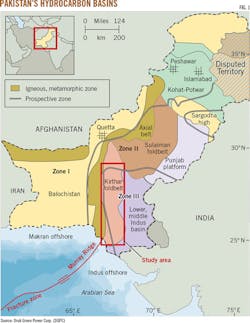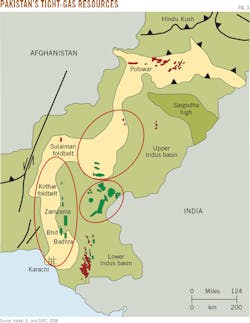Pakistan's Kirthar fold belt tight-gas reservoirs show development potential
Abdul Majeed
NED University of Engineering and Technolgy
Karachi, Pakistan
Aftab Ahmed Mahessar
Khalil ur Rehman Memon
Mehran University of Engineering and Technology Sindh, Pakistan
Samples collected from the Kirthar fold belt area near BHP Billiton Ltd.'s Rehmat gas field in the Dadu district near Sindh, Pakistan (Fig. 1), will provide new direction in the development of tight-gas reserves in Pakistan.1 2
Pakistan's exploration companies are reluctant to invest capital in the country's low-permeability, tight-gas reservoirs, as production from these sandstone formations is often only marginally profitable. Reducing the cost of unconventional development is key to replacing Pakistan's declining conventional reserves.
Tight gas
Pakistan's tight-gas unconventional reservoirs are characterized by low matrix porosity (≤10%) and permeability ≤0.1 md, exclusive of fracture permeability. They commonly consist of sandstone and siltstone, but carbonate rocks can also produce tight-gas.3
Recoverable tight-gas reserves account for 2,649 tcf worldwide (Table 1).4 The US has the largest tight gas reserves with produced gas plus proven reserves of 92 tcf, according the Gas Technology Institute (GTI). GTI also estimates that 20% of US gas production comes from tight gas reservoirs (Fig. 2).5
Domestic natural gas production meets 50% of Pakistan's total energy consumption, while oil supplies 30%. Coal accounts for 6.5% of Pakistan's energy mix, with the remaining 13.5% filled by hydroelectric and nuclear.6 The majority of Pakistan's crude is imported.
Kirthar fold belt
The Kirthar fold belt contains a 2,000-sq-mile prospective tight-gas area with a resource concentration of 40 tcf. Fig. 3 shows total known unconventional reserves in Pakistan.7 8
The Kirthar fold belt is structurally and stratigraphically equivalent to the Suleiman fold belt and trends north-south tectonically. In this area the rocks deposited were from Triassic to recent. From its western flank the Kirthar fold belt connects with the Balochistan basin. Its western margin is associated with hydrothermal activities.9
The SML-Laki limestone surfaces in the southern Kirthar fold belt, but not in its northern part. Several wells have encountered this unit, including Tangna Pusht X-1, Jhal Magsi South-1, Mazarani-1, and Bhan-1. The SML-Laki consists mainly of platform limestone deposits. The limestone is medium-hard to hard, crystalline, argillaceous, fossiliferous, and shales out in the Tangna Pusht Nala, Johan, and South Karkh sections, as well as the Hallel-1 well. The limestone is also mapped as the Ghazij formation.
Study methodology
Our research study tested 3-6 cm long outcrop and reservoir core plugs with an average length of 2.48 cm. The cylindrical samples were placed in a hasseler core holder at a confining pressure of around 500 psi. This step prevented permeant leakage through the side cores. Using air as the coring fluid minimized damage to core plugs. Rectilinear block retrieval used tap water as the coring fluid. Researchers cleaned each sample in Soxhlet extractor with a zeotropic methanol-dichloromethane mixture and followed this with methanol to extract salt and organic matter that they then dried in an oven at 80° C.
After 2 days researchers began randomly checking the weight of samples until no change was observed. Samples were cooled to room temperature before each measurement and researchers confirmed lengths and diameters with calipers. Permeability in each core plug was measured with helium gas with a steady-state technique for samples with permeability >0.1 md and by pulse decay for samples with permeability <0.1 md.
Increasing confining stress to 500 psi prevented gas passing from the sides of the samples. Permeability stress-sensitivity was confirmed by applying further stress up 2,500 psi. A brine NaCl concentration of 5% passed through a 0.45 mm filter and was degassed to assess the water sensitivity of each core plug. The 5% brine solution was independently measured by a rolling ball viscometer.
Stress effects
Experiments investigated the stress dependence of single-phase gas permeability in tight gas samples divided into two groups. Group A consisted of samples with higher permeability values (Samples JSI-JSV), while Group B (JSVI-JSX) was made up of samples displaying predominantly lower values. Steady state permeability measurements on both groups of samples were corrected for the Klinkenberg effect. Table 2 shows the permeability results for both groups.
The moderately permeable samples in Group A experienced an 11-50% reduction in permeability as confining pressure rose to 2,500 from 500 psi (Table 3). The Group B samples showed lower permeability than Group A, except Sample JSVI, which is highly permeable and less stress dependent. It showed a 4% reduction in permeability as confining stress rose to 2,500 psi.
The five low-permeability samples in Group B decreased 40-70% as confining pressure increased to 2,500 psi from 500 psi. Results show these sandstones' permeability as stress dependent in the tested range. Samples B-4 and B-5 permeability, for example, falls to about 70% as confining pressure is increased to 2,500 psi. The stress dependence of these samples' permeability appears to decrease as confining pressure is increased. Absolute permeability of tight rock samples from the Kirthar fold belt region shrinks and at low ambient stress (confining pressure) and permeability can by overestimated by half an order of magnitude.
Kirthar potential
The experiments and laboratory-collected data show that the petrophysical properties predicting performance of tight-gas sandstone reservoirs (permeability, capillary pressure, electrical resistivity, and relative permeability) are controlled by microstructure (volume and position of clays, grain size, and sorting). Absolute permeability is stress dependent in the laboratory, and this could also be the case in the subsurface.10 The study conducted on the Kirthar fold belt samples justifies testing the impact of restricted rate practices in this tight-gas, sandstone reservoir.
Brine permeability is about five times lower than gas permeability, which has implications for the rate of water influx into tight-gas reservoirs with large aquifers. This study did not identify an obvious control on the ratio of gas to brine permeability, i.e. clay content, type, position, pore throat size.
References
1. Heikal, S., "Scope of Tight Gas Reservoir in Pakistan," Pakistan Petroleum Exploration & Production Companies Association (PPEPCA), Islamabad, Pakistan, Nov. 3-4, 2008.
2. Naik, G.C., "Tight Gas Reservoirs - An Unconventional Natural Energy Source for the Future," 2002, pp. 32.
3. Alam, S., "Potential of Tight Gas in Pakistan: Productive, Economic and Policy Aspects," Pakistan Association of Petroleum Geoscientists (PAPG), Annual Technical Conference, Islamabad, Nov. 10-11, 2010.
4. US Energy Information Administration (EIA), "Technically Recoverable Shale Oil and Shale Gas resources: An Assessment of 137 Shale Formations in 41 Countries outside the United States," June 2013, pp. 76.
5. EIA, "World Shale Gas Resources: An Initial Assessment of 14 regions outside the United States," April 2011, pp. 365.
6. Ahmad, N., Mateen, J., Shehzad Ch, K., Mehmood, N., and Arif, F., "Petroleum Geology of Kirthar Sub-basin and Part of Kutch Basin," Pakistan Journal of Hydrocarbon Research, Vol. 22-23, June 2012-13, pp. 51-62.
7. Directorate General of Petroleum Concessions-Pakistan (DGPC), "Petroleum (Exploration and Production) Policy," Ministry of Petroleum & Natural Resources, Islamabad, Pakistan, 2009, www.planningcommission.gov.pk.
8. Heikal, S., "Scope of Tight Gas Reservoir in Pakistan," PPEPCA, Islamabad, Pakistan, Nov. 3-4, 2008.
9. Smewing, J.D., Warburton, J., Daley, T., Copestake, P., and Ul-Haq, N., "Sequence stratigraphy of the southern Kirthar Fold Belt and Middle Indus Basin, Pakistan" Geological Society of London, Special Publications, Vol. 195, pp. 273-299.
10. Wei, K.K., Morrow, N.R., and Brower, K.R., "Effect of Fluid, Confining Pressure, and Temperature on Absolute Permeabilities of Low-Permeability Sandstones," Society of Petroleum Engineers, Formation Evaluation, Vol. 1, No. 4, August 1986, pp. 11.
The authors
Abdul Majeed ([email protected]) serves as faculty in the petroleum engineering department at NED University of Engineering and Technology, Karachi, Sindh, Pakistan. Before this, he worked as an assistant professor in the department and as a research assistant at the University of Leeds, UK. He earned his PhD in petroleum engineering in June 2015 from the University of Leeds and an MS in petroleum engineering in 2008 from Heriot Watt University, Edinburgh.
Aftab Ahmed Mahesar ([email protected]) serves as faculty at the Institute of Petroleum and Gas Engineering at Mehran University of Engineering and Technology, Jamshoro, Sindh, Pakistan. Before this, he worked as a petroleum engineer for various oil and gas companies. He is currently completing his PhD.




